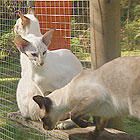Breed: Siamese
Temperament: demanding and lively
Cost: $250+(pet), $500+(show)
Lifespan: 12-17 years
Maintenance: low
Recommended for: anyone who loves cats, home units
History
As the name implies, the Siamese origins lie in a south-east Asian country once called Siam, now called Thailand. It is one of the most widely recognised of all the cat breeds and is in fact the foundation for many other breeds we see today.
The Siamese cat we know today is vastly different from those which were brought to England and first shown at Crystal Palace in 1871. In fact, they’re quite different from those ‘Siamese’ cats which are still popular throughout Thailand. Present day Siamese from European lines are much slimmer and appear in many more colours than the original stock or those cats still native to Thailand.
The Siamese is amongst the most popular of cat breeds in Australia, with many breeders throughout the states.
Appearance
Apart from its slender, svelte body the most distinctive characteristic of the Siamese is its pale coat with dark points (the ears, mask, paws and tail). The coat is short and fine, with no undercoat. A wide variety of colours are also available. Ranging from blue to red, chocolate, lilac, cream, caramel, apricot, fawn and cinnamon. The points may be either solid, tabby or torti. However not all colours are available with each of these point types. Interestingly, the depth of colour of the coat is in part determined by the climate. Known as thermosensitivity, the points will be darker in colder climates than warm ones. Even in warm climates there will be differences in the depth of colour as bleaching and colour genetics will contribute to variation.
Temperament
Active, feisty and very demanding. Siamese are a very vocal breed, often emitting a persistent rasping meow until their needs are met. Siamese can have a reputation for aggression and poor temperament and this may not be helped by current breeding practices. A great many Siamese however are sociable and friendly animals and remain devoted to their family. This devotion though can be sorely tested on occasion. Siamese are notorious for scratching furniture, climbing up curtains and general mischief. A water bottle able to squirt the offending feline is an often used method of control. Provide scratching poles and other stimuli to help keep the cat occupied. Siamese are also very territorial and keen hunters. In the interests of native wildlife it is advisable to erect a cat enclosure.
Grooming
The coat is very easy to care for. A ten minute brush weekly, or even some loving stroking daily, will keep the coat looking glossy and free of dead hair. Siamese will moult twice a year, approaching the warmer and cooler months.
Health and breeding
Breeding practices have led to certain unfortunate health issues. The desire to produce Siamese with a narrow, gaunt appearance has caused the breed to suffer. The breed now has a much narrower head than once before. This desire to make the cranium smaller can affect vision and is known to cause congenital squinting amongst some Siamese, which may lead to loss of sight. A smaller cranium will also naturally lead to a smaller brain, an outcome which is not likely to benefit the breed in terms of temperament. These waif-like types have also exhibited a reduced immunity which can lead to chronic respiratory diseases. Lymphosarcoma, a heritable cancer, has also been reported. A return to breed selection of Siamese with a more robust shape and placid temperament would certainly be in the best interests of the breed. Incidence of kinked tails and cross-eyes have also occurred but are seldom seen in current Australian lines.
Healthy Siamese can live up to 12-17 years. Kittens mature quickly and can breed from five months with queens regularly coming into heat every couple of months. Desex from 12 weeks. The slender shape of the breed may also cause problems during kittening, due to a narrow pelvis. As the Siamese is a pure breed, matings of like to like will always breed true, unlike some oriental breeds.
Cost and feeding
If you just want a pet, expect to pay between $250 – $300. A show quality kitten may cost between $500 – $800. Siamese have no particular dietary requirements which differ from other breeds. However it is important not to spoil your little mate, otherwise you will have to cope with a very demanding pussy.
Recommended for
Many people love the breed. If you’re a cat lover and prepared for their demanding nature, then the Siamese can make a great pet. They’re low maintenance, quite often very long lived and are still one of the most popular of all felines.
Further information
We filmed this segment in New South Wales with Siamese breeder Hetty Berntrop. Hetty can be contacted on (02) 4889 8978.
NSW
Breeder Bambi Edwards
Phone: (02) 9523 3507
ACT
Breeder Lesley Roberts
Phone: (02) 6231 6538
QLD
Siamese and Oriental Cat Club of Qld
Secretary Heather Brown
Phone: (07) 5464 1723
SA
Siamese Cat Club of SA
Breeder Allan Patching
Phone: (08) 8396 3071
VIC
Royal Sacred Siamese Cat Club
President Jan Overton
Phone: (03) 9560 1080
WA
Siamese Cat Club of WA
Breeder Anne Knox
Phone: (08) 9410 2595
Cat enclosures, both permanent and free standing, are supplied by specialist companies such as CatmaxTM. Contact 1300 306 605.
Music from ‘The King & I’ was courtesy of 20th Century Fox Home Entertainment and can be purchased from music centres on video and DVD.



